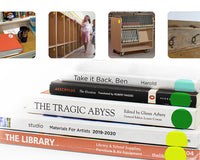
Many things can go wrong in a small business, and a good amount of them could be solved through simple organization. According to Fundera, “two-thirds of businesses survive two years in business, half of all businesses will survive five years, and one-third will survive 10 years.” Not knowing where important information lies can greatly hurt small businesses and their practices. Through organization, you can easily find items you need without the hassle of making a mess worse, which takes you away from other, more important matters. Figure out how to organize your small business from the start, so you don’t have to deal with the repercussions later. To prepare, here are some helpful organizational tips for small businesses.
Establish an Office
With small businesses, you are often limited by space, that doesn’t give you an excuse to be disorganized. If you have the building space, establish an office where most of the important information will lie. This will act as a central storage hub for desks, cabinets, and documents. Having this all located in one space is an efficient option for your small business operations.
Use Shelves
In this office room, you may not have as much room as you would hope for. One way you can get around the space you are given is to use the vertical space in the room. That’s why our next organizational tip for small businesses is to use shelves to your advantage. These will allow you to fit as many items as you need in a close and confined area. If you do opt for shelving, be sure you have a stepping stool, so you have a safe way to get whatever you need off a shelf and so nothing is out of reach for employees.
Label Everything
There’s a good chance this office space will have plenty of boxes on these shelves. To ensure that you never lose or misplace anything—label everything. The best way to go about labeling is to use colored circle labels. Colored circles will not only let you label what’s inside the content, but they can help you organize each shelf. By categorizing with colors, it’ll be even easier to find what you are looking for. For this to work, establish a shelving system so you can continue to organize correctly when you get new items and keep it consistent.
Take Advantage of Technology
One of the great benefits of technology is that it eliminates the need for physical documents, which can take up a lot of space in any given room. Today, you can have digital copies of important information stored on a computer or tablet. Take advantage of this opportunity when you are working with a limited space, because some items can’t be stored digitally.
Organize Your Desktop and Tablet
Organization is completely necessary in the digital space as well. If you open your desktop or tablet and are welcomed by a plethora of icons and apps, it’s a sign you need to sort things out. A major step you can take in sorting out your device is to use folders. Come up with some categories and create a folder based on each one. Then, place all the corresponding documents into the appropriate folder. While it’s easier to imagine a physical space becoming disorganized, the digital space can become just as much of a mess if you decided to go digital for most of your documents.
Create a Filing System
While you should try to avoid the clutter by eliminating physical documents, some things still need to be physical. This means that some information needs to be stored in a cabinet. To ensure that physical space doesn’t become disorganized, create a filing system. A filing system should also consist of color-coded labels that will allow someone to easily locate the file they are looking for. The folder itself should have a color and a label on a tab in some specific order. A filing system is the best way to organize personal files—undoubtedly, it’s better than creating a messy pile on a desk.
Set Storage Boundaries
Your storage room will surely have a desk, cabinets, and shelves. The best way to organize the space itself and eliminate confusion is to set boundaries. This essentially means that you will want a layout with the shelves in one area with cabinets and a desk in another. You run the risk of creating a crowded area if you start to mix and match storage because it’s all randomly laid out.
Communicate the System to Employees
For your small business to remain organized, the system and process needs to be communicated to employees. Business operations can become unhinged easily if employees are not on the same page. Include organization practices into training, so everyone knows where important documents and other storage are supposed to go. This will prevent employees from misplacing items because they’ll have the prior knowledge of where it should be placed.
Designate Cleaning Days
Things inevitably get messy, which is why you should designate cleaning days—that way, things won’t get entirely out of order. While cleaning up should be a given, it can be easy to never fully sort through what is in the storage room or office. Make it a point to go through the storage and ensure that everything is in its correct place. By taking this proactive approach, you decrease the risk of losing valuable items and documents.
Prioritize Information
A key way you can improve the organization within your small business is to have important information be easily accessible. This goes back to figuring out your layout. If you are a small business that will always have to grab items from storage, prioritize this by putting that information towards the front. Same goes for if your small business is always going through the cabinet. This may not be something you know of right away, but as soon as you do, rearrange the layout to whatever works best for your small business practices. After all, that essential information will soon become clear—and with it, you can tailor your storage room and methods to fit your needs.







